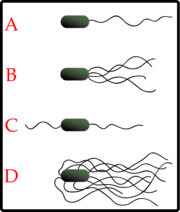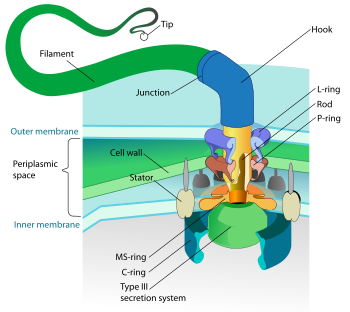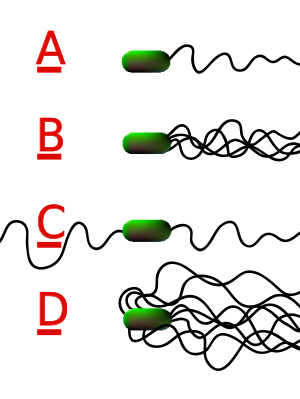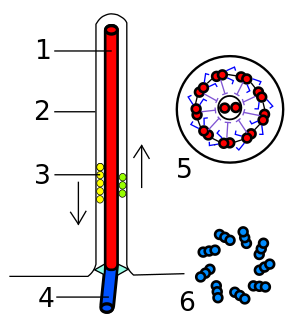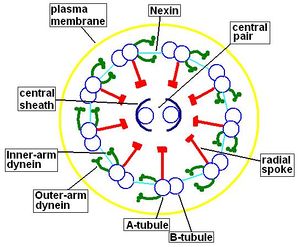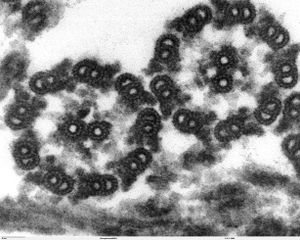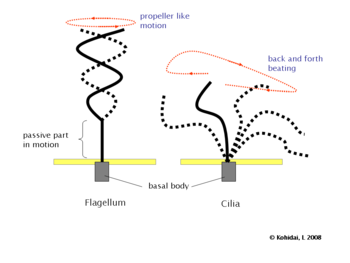سوط (أحياء)
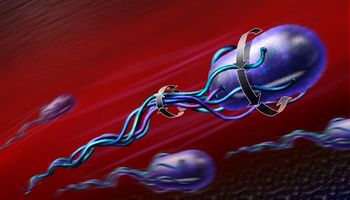
السوط flagellum (ج.: سياط flagella) بنية سطحية لخلايا حقيقيات النوى أو بدائيات النوى تساعدها على الحركة[1][2] في الوسط السائل أو على سطح وسط جامد. توجد فروق هامة بين السياط عند حقيقيات النوى وبدائيات النوى من حيث تركيبها البروتيني وآلية الدفع والبنية، حيث ثخن السوط عند البكتيريا من 10 إلى 20 نم، و لذلك لا يمكن رؤيته بواسطة المجهر الضوئي، وطوله 3-15 ميكرون، بينما قد يصل ثخن السوط عند حقيقيات النوى إلى 200 نم وطوله إلى 200 ميكرون. وتتشابه بنية السياط والأهداب عند حقيقيات النوى، وقد تختلف بالوظيفة أو الطول[3].
النطفة مثال على خلية حقيقية النواة تستعمل سوطها للتحرك نحو الجهاز التناسلي الأنثوي وضمنه[4]، والملويات البوابية مثال على بكتيريا ذات سياط متعددة تساعدها على الحركة عبر المخاط للوصول إلى ظهارة جهاز الهضم[5].
تتكون من مواد بروتينية،و يسمى هذا البروتين فلاجيلين ويكون على شكل سلك أو سوط. و تقوم بمساعدة البكتيريا وغيرها من الخلايا على الحركة. ففي عالم البكتيريا يطلق على البكتيريا التي تمتلك سياط بأنها متحركة. و و تعتبر السياط من الصفات المميزة للبكتيريا و التي يمكن استخدامها في عملية التصنيف.
وظيفة السياط
تساعد الخلية على الحركة حيث تدفعها للانتقال.، فهي على سبيل المثال توجد في الحيوان المنوي ، كما توجد لدى الخلية البكتيرية.
الأنواع
البكتيرية
في الخلية البكتيرية توجد السياط بأنماط متعددة:
- فقد تحيط السياط بالخلية من كل اتجاه و في هذه الحالة تسمىإنگليزية: peritrichous bacteria
- أو قد تكون السياط متجمعة في مكان واحد من الخلية البكتيرية و توصف بهذه الحالة بأنها إنگليزية: lophotrichous bacterium
- و قد يتصل بخلية البكتيريا صوت واحد فقط على اتجاهين مختلفين و في هذه الخلية تسمى إنگليزية: amphitrichous
- و قد يوجد على خلية البكتيريا صوت واحد فقط و في جهة واحدة فقط و في هذه الحالة تسمىإنگليزية: monotrichous bacterium.
Archaeal
حقيقية النوى
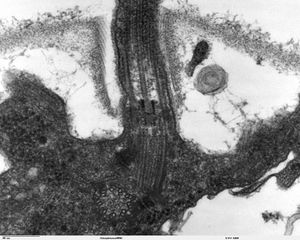
Along with cilia, flagella make up a group of organelles known as undulipodia.
Flagella vs Cilia
"تعقيد غير قابل للتبسيط"
انظر أيضاً
المراجع
- ^ Bardy S.L., Ng S.Y., Jarrell K.F. (2003). "Prokaryotic motility structures". Microbiology. 149 (Pt 2): 295–304. doi:10.1099/mic.0.25948-0. PMID 12624192.
{{cite journal}}: Unknown parameter|quotes=ignored (help)CS1 maint: multiple names: authors list (link) - ^ Lefebvre P.A. (2001). "Assembly and motility of eukaryotic cilia and flagella. Lessons from Chlamydomonas reinhardtii". Plant Physiology. 127 (4): 1500–1507. doi:10.1104/pp.010807. PMID 11743094.
{{cite journal}}: Unknown parameter|quotes=ignored (help) - ^ Haimo L.T., Rosenbaum J.L. (1981). "Cilia, flagella, and microtubules". Journal of Cell Biology. 91 (3 Pt 2): 125s–130s. doi:10.1083/jcb.91.3.125s. PMID 6459327.
{{cite journal}}: Unknown parameter|quotes=ignored (help) - ^ Malo A.F.; et al. (2006). "Sperm design and sperm function". Biology Letters. 2 (2): 246–9. doi:10.1098/rsbl.2006.0449. PMID 17148374.
{{cite journal}}: Explicit use of et al. in:|author=(help); Unknown parameter|pmcid=ignored (|pmc=suggested) (help); Unknown parameter|quotes=ignored (help) - ^ Lacy B.E., Rosemore J. (2001). "Helicobacter pylori: ulcers and more: the beginning of an era". Journal of Nutrition. 131 (10): 2789S–93S. PMID 11584108.
{{cite journal}}: Unknown parameter|quotes=ignored (help)
وصلات خارجية
- "Molecular Machines Museum Index". Access Research Network. 2001. Retrieved 2008-05-18.
{{cite web}}: Cite has empty unknown parameter:|coauthors=(help)
- Howard Berg (1999). "Motile Behavior of Bacteria". Physics Today on the Web. American Institute of Physics. Retrieved 2008-05-18.
{{cite web}}: Cite has empty unknown parameter:|coauthors=(help)
- Charles Lindemann (2008-04-04). "Mechansims of sperm motility". Oakland University. Retrieved 2008-05-18.
{{cite web}}: Cite has empty unknown parameter:|coauthors=(help)
This article incorporates content from the 1728 Cyclopaedia, a publication in the public domain.
